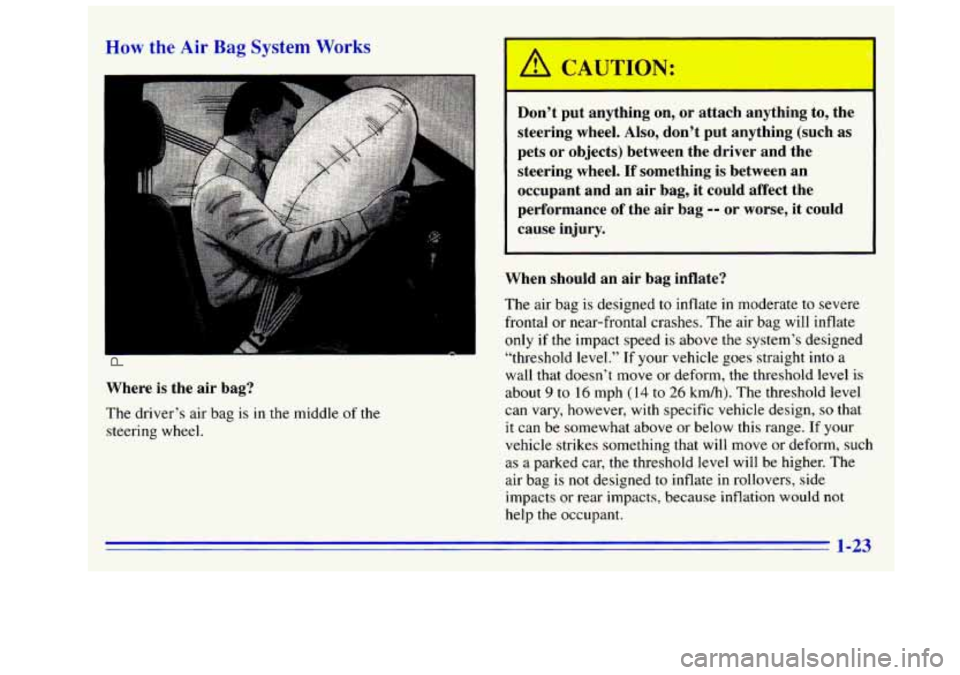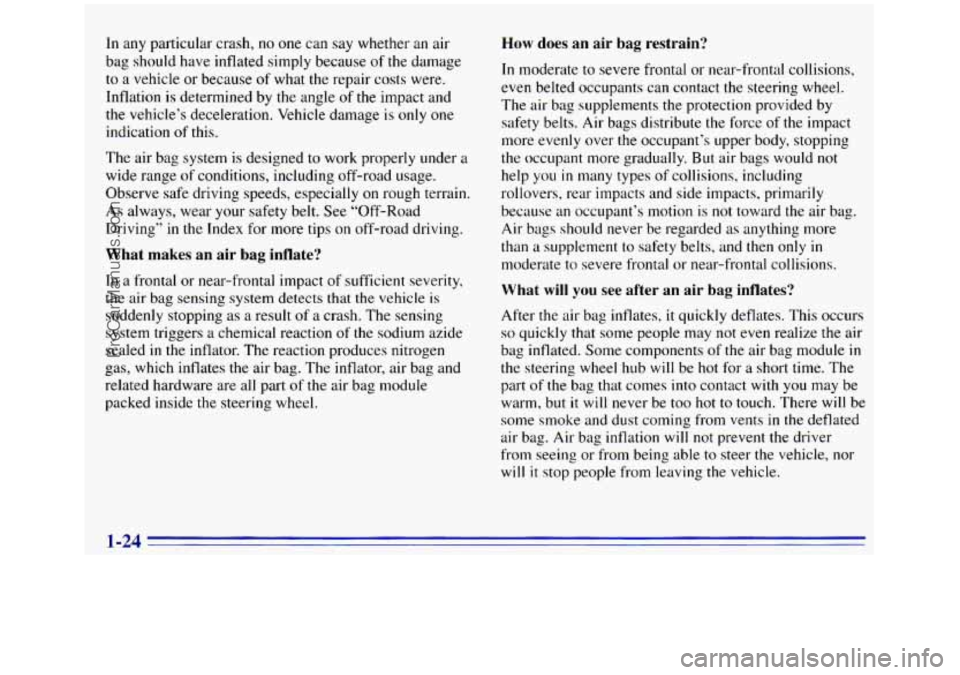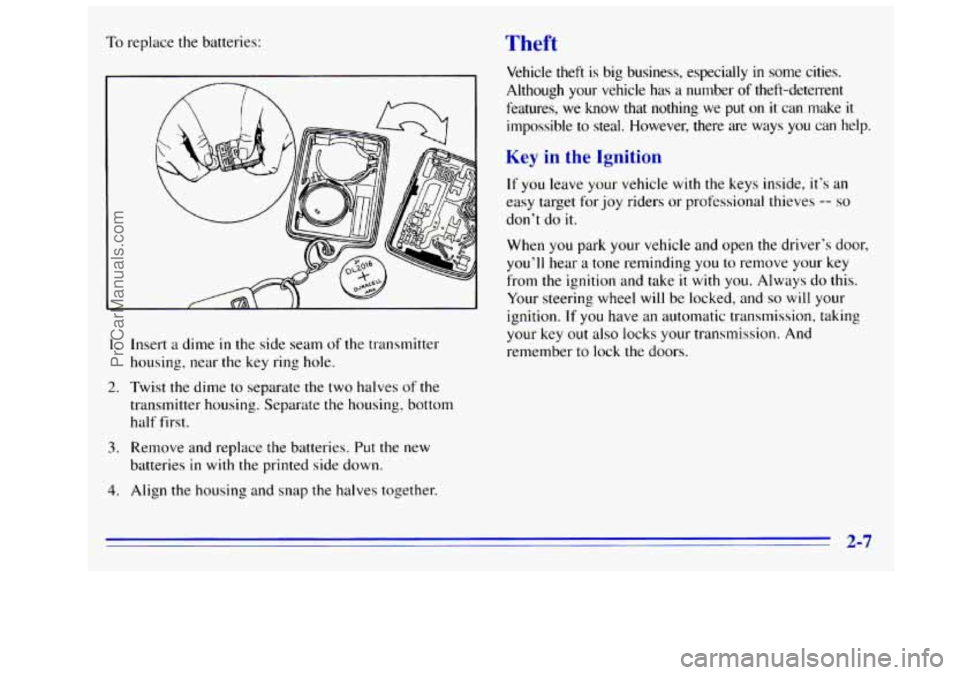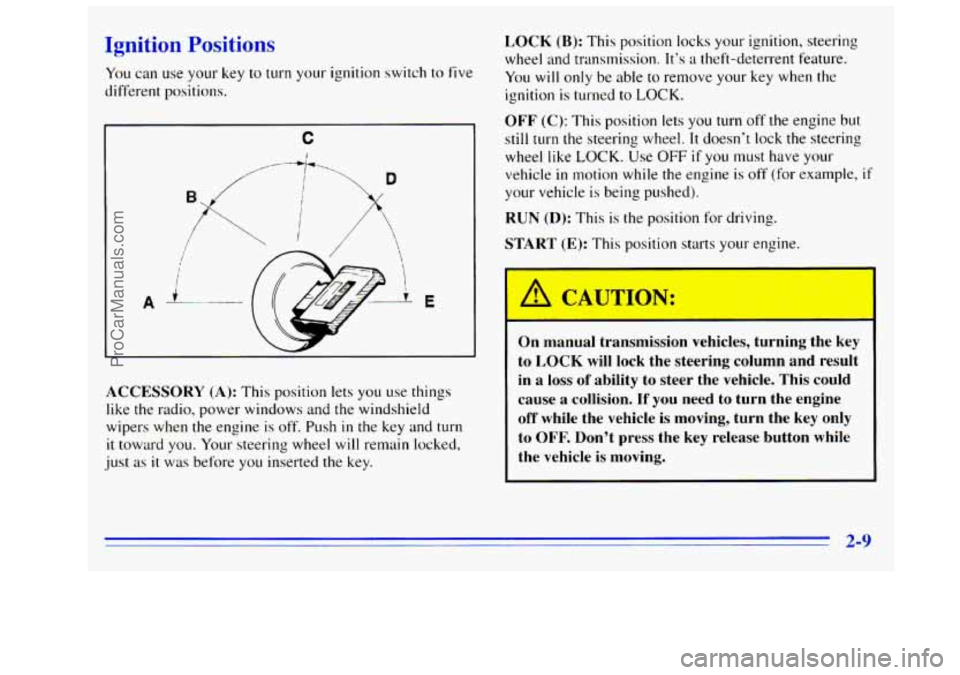Page 17 of 404
i
Your vehicle has a light
that comes on as a reminder
to buckle up. (See “Safety
Belt Reminder Light” in
the Index.)
In most states and Canadian provinces, the law says
to
wear safety belts. Here’s why: They work.
You never know if you’ll be in a crash. If you do have a
crash, you don’t know
if it will be a bad one.
A few crashes are mild, and some crashes can be
so serious that even buckled up a person wouldn’t
survive.
But most crashes are in between. In many of
them, people who buckle up can survive and sometimes
walk away. Without belts they could have been badly
hurt or killed.
After more than
25 years of safety belts in vehicles,
the facts are clear. .In most crashes buckling up does
matter
... a lot!
Why Safety Belts Work
When you ride in or on anything, you go as fast
as it goes.
Take the simplest vehicle.
Suppose it’s just a seat
on wheels.
1-9
ProCarManuals.com
Page 29 of 404
To unlatch the belt, just push the button on the buckle.
The belt should go back out
of the way.
Before you close the door, be sure the belt is out
of the
way. If you slam the door on it,
you can damage both the
belt and your vehicle.
Supplemental Inflatable Restraint
(SIR) System
This part explains the Supplemental Inflatable Restraint
(SIR) system or air bag system.
Your vehicle may have
an air bag for the driver.
If it does, it will say
Supplemental Inflatable
Restraint on the middle part
of the steering wheel.
1-21
ProCarManuals.com
Page 31 of 404

he Air Bag System Works
Where is the air bag?
The driver’s air bag is
in the middle of the
steering wheel. Don’t
put anything on, or attach anything to, the
steering wheel. Also, don’t put anything (such
as
pets or objects) between the driver and the
steering wheel. If something is between an
occupant and an air bag, it could affect the
performance
of the air bag -- or worse, it could
cause injury.
When should an air bag inflate?
The air bag is designed to inflate
in moderate to severe
frontal
or near-frontal crashes. The air bag will inflate
only if the impact speed is above
the system’s designed
“threshold level.”
If your vehicle goes straight into a
wall that doesn’t move or deform, the threshold level
is
about 9 to 16 mph (14 to 26 km/h). The threshold level
can vary, however, with specific vehicle design, so that
it can be somewhat above or below this range. If your
vehicle strikes something that will move or deform, such
as a parked car,
the threshold level will be higher. The
air bag is
not designed to inflate in rollovers, side
impacts or rear impacts, because inflation would not
help the occupant.
1-23
ProCarManuals.com
Page 32 of 404

In any particular crash, no one can say whether an air
bag should have inflated simply because of the damage
to a vehicle or because
of what the repair costs were.
Inflation is determined by the angle of
the impact and
the vehicle’s deceleration. Vehicle damage is only one
indication
of this.
The air bag
system is designed to work properly under a
wide range of conditions, including off-road usage.
Observe safe driving speeds, especially
on rough terrain.
As always, wear your safety belt. See “Off-Road
Driving”
in the Index for more tips on off-road driving.
What makes an air bag inflate?
In a frontal or near-frontal impact of sufficient severity,
the air bag sensing system detects that
the vehicle is
suddenly stopping as a result of a crash. The sensing
system triggers
a chemical reaction of the sodium azide
sealed
in the inflator. The reaction produces nitrogen
gas, which inflates the air bag. The inflator, air bag and
related hardware are all part of the air bag module
packed inside the steering wheel.
How does an air bag restrain?
In moderate to severe frontal or near-frontal collisions,
even belted occupants can contact the steering
wheel.
The air bag supplements the protection provided by
safety belts. Air bags distribute the force of the impact
more evenly over the occupant’s upper body, stopping
the occupant more gradually. But air bags would
not
help you in many types of collisions, including
rollovers, rear impacts and side impacts, primarily
because an occupant’s motion
is not toward the air bag.
Air bags should never be regarded as anything more
than a supplement
to safety belts, and then only in
moderate to severe frontal or near-frontal collisions.
What will you see after an air bag inflates?
After the air bag inflates, it quickly deflates. This occurs
so quickly that some people may not even realize the air
bag inflated. Some components
of the air bag module in
the steering wheel hub will be hot for a short time. The
part of the bag that comes into contact with you
may be
warm, but
it will never be too hot to touch. There will be
some smoke and dust coming from vents
in the deflated
air bag.
Air bag inflation will not prevent the driver
from seeing or from being able
to steer the vehicle, nor
will it stop people from leaving the vehicle.
1-24
ProCarManuals.com
Page 69 of 404

To replace the batteries: rheft
1. Insert a dime in the side seam of the transmitter
housing, near
the key ring hole.
2. Twist the dime to separate the two halves of the
transmitter housing. Separate the housing, bottom
half first.
3. Remove and replace the batteries. Put the new
batteries
in with the printed side down.
4. Align the housing and snap the halves together. Vehicle theft is big business, especially
in some cities.
Although your vehicle has
a number of theft-deterrent
features, we know that nothing
we put on it can make it
impossible to steal. However, there are ways you can help.
Key in the Ignition
If you leave your vehicle with the keys inside, it’s an
easy target for joy riders or professional thieves
-- so
don’t do
it.
When you park your vehicle and open the driver’s door,
you’ll hear a tone reminding you to remove your key
from the ignition and take
it with you. Always do this.
Your steering wheel
will be locked, and so will your
ignition.
If you have an automatic transmission, taking
your key out also locks
your transmission. And
remember to lock
the doors.
2-7
ProCarManuals.com
Page 71 of 404

Ignition Positions
You can use your Key to turn your ignition switch to five
different positions.
C
1
E
W
LCCESSORY (A): This position lets you use things
like the radio, power windows and the windshield
wipers when the engine is off. Push
in the key and turn
it toward you. Your steering wheel will remain locked,
just
as it was before you inserted the key. LOCK
(B): This
position locks your ignition, steering
wheel
and transmission. It's a theft-deterrent feature.
You will only be able to remove your key when the
ignition is turned to
LOCK.
OFF (C): This position lets you turn off the engine but
still
turn the steering wheel. It doesn't lock the steering
wheel like
LOCK. Use OFF if you must have your
vehicle in motion while the engine is off (for example, if
your vehicle is being pushed).
RUN
(D): This is the position for driving.
START
(E): This position starts your engine.
I
I A CAUTION:
On manual transmission vehicles, turning the key
to LOCK will lock the steering column and result
in
a loss of ability to steer the vehicle. This could
cause
a collision. If you need to turn the engine
off' while the vehicle is moving, turn the key only
to
OFF. Don't press the key release button while
the vehicle is moving.
ProCarManuals.com
Page 72 of 404
NOTICE:
If your key seems stuck in LOCK and you can’t
turn it, be sure it is
all the way in. If it is, then
turn the steering wheel left and right while
you
turn the key hard. But turn the key only with
your hand. Using a tool to force it could break
the key or the ignition switch.
If none of this
works, then your vehicle needs service.
Key Release Button
The ignition key cannot be
removed from the ignition
of manual transmission
vehicles unless the key
release button
is used.
To remove the key on manual transmission vehicles,
turn the key to the
OFF position, then press the button
and
turn the key to the LOCK position. Do not hold the
button
in while turning the key to OFF. Keeping your
finger on the button,
pull the key straight out.
On automatic transmission vehicles, turn the key to
LOCK and
pull it straight out.
2-10
ProCarManuals.com
Page 76 of 404

PARK (P): This locks your rear wheels. It’s the best
position
to use when you start your engine because your
vehicle can’t move
easily.
It is dangerous to get out of your vehicle if the
shift lever is not fully in PARK
(P) with the
parking brake firmly set. Your vehicle can roll.
Don’t leave
your vehicle when the engine is
running unless you have to.
If you have left the
engine running, the vehicle can move suddenly.
You or others could be injured. To be sure your
vehicle won’t move, even when you’re on fairly
level ground,
always set your parking brake and
move the shift lever to
PARK (P).
I
CAUTION: (Continued)
-
if’ you have four-wheel drive, your vehicle
will be free to roll -- even if your shift lever
is in PARK
(P) -- if your transfer case is in
NEUTRAL (N). So, be sure the transfer case is
in a drive gear, two-wheel high
(2H) or four-wheel
high
(4H) or four-wheel low (4L) -- not in
NEUTRAL
(N). See “Shifting Into PARK (P)” in
the Index. If you’re pulling
a trailer, see “Towing a
Trailer” in the Index.
2-14
ProCarManuals.com